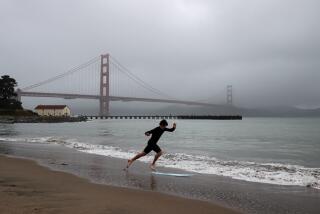Water Board Weighs Views on Hyperion
More than 500 people turned out at a regional water quality hearing Monday to protest continued dumping of partially treated sewage in the Santa Monica Bay.
The Los Angeles Regional Water Control Board met at the State Building in downtown Los Angeles to hear final arguments from environmentalists opposing the city’s request for a waiver that would allow the city to continue pumping partially treated sewage and sludge into the bay.
The sewage and sludge is pumped from the Hyperion Sewage Treatment Plant in Playa del Rey after getting what is called primary treatment that removes about 60% to 70% of toxic wastes and heavy metals.
No decision is expected until early summer. The board’s staff workers are recommending approval of the city’s request for the exemption.
The city’s bid for such a waiver was tentatively approved by the Environmental Protection Agency in 1981. The regional water board’s approval was considered the last major hurdle to getting the waiver.
500 Crowd Hearing
About 500 people from a group called the Coalition to Stop Dumping Sewage into the Ocean and others opposing the waiver crowded into the hearing Monday to voice their opposition to the city’s application.
Carla Bard, a former state water quality official, told the board that there was a great deal of information against granting the waiver during the Carter Administration when the application was made by the city in 1977. She said data about the effects of sewage pumping was changed during the Reagan Administration by Ann Gorsuch Burford before she was forced to resign as EPA administrator in 1983.
“In view of the two conflicting EPA reviews, you will wish to remove any taint remaining from the Gorsuch decision,” Bard told board members.
Hyperion, which handles 420 million gallons of sewage daily, gives secondary treatment to only about 25% of the effluent. City officials want a waiver to avoid federal standards that would eventually require secondary treatment of all the sewage.
Marginal Improvement
City officials say they want the waiver because they are planning a $180 million construction project so that Hyperion can meet standards of the California Ocean Plan approved in 1983. They say providing full secondary sewage treatment would add another $155 million in costs and provide only marginal improvement in quality of the sewage discharged.
Dr. Rimmon Fay, a marine biologist and former member of the state Coastal Commission, argued the sewage discharge has harmed the environment.
“What you don’t see anymore are large quantities of baby fish,” he said. “You don’t see the beds of shellfish, the lobsters, the abalone that were present here before.”
Fay’s views are challenged by Willard Bascom, director of the Coastal Water Research Project, an organization partly funded by the city, which has monitored the bay for 15 years.
Bascom said his studies have shown no damaging effects on marine animals even if underwater conditions have been contaminated near the Hyperion discharge lines in the bay.
More to Read
Sign up for Essential California
The most important California stories and recommendations in your inbox every morning.
You may occasionally receive promotional content from the Los Angeles Times.










